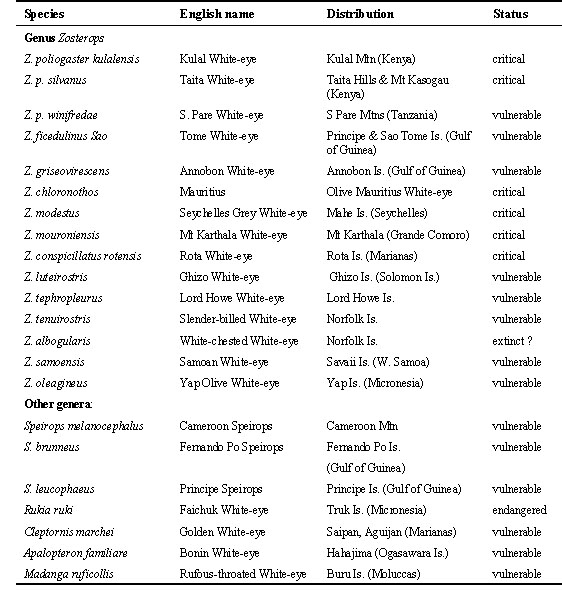
RT28: Evolution within Zosteropidae (white-eyes) and conservation of island populations
Jiro Kikkawa1 & Rick J. Nuttall2
1Department of Zoology, The University of Queensland, Brisbane, Qld 4072, Australia, fax 61 7 3365 1655, e-mail
jkikkawa@zoology.uq.edu.au; 2National Museum, Bloemfontein 9300, South Africa, e-mail ornito@nasmus.co.zaKikkawa, J. & Nuttall, R.J. 1999. Evolution within Zosteropidae (white-eyes) and conservation of island populations. In: Adams, N.J. & Slotow, R.H. (eds) Proc. 22 Int. Ornithol. Congr., Durban: 3212-3214. Johannesburg: BirdLife South Africa.
Among the rapidly evolving passerines, the Family Zosteropidae is remarkable in showing measurable differentiation in historical times (see S32.2, Oral05.7 and I33 of this Congress). The Family is a highly homogeneous group with only a few genera (e.g. Speirops, Woodfordia) having aberrant characters. Their geographic range is restricted to the Old World except Europe. Relationships between the African species (6 polytypic and 12 monomorphic) and Indo-Pacific species (split into some 70) is unclear, but the members of the predominant genus Zosterops (white-eyes) in both regions have a strong tendency to migrate or disperse in flocks. They have colonised more oceanic islands than any other passerine group in the Indian Ocean and the western Pacific. Despite such strong mobility, they have become profoundly sedentary on islands and mountains, sometimes within sight of each other. In these isolated populations, phenotypic differentiation can be very rapid. The Family also contains 22 threatened species and subspecies (Table 1), some of which are critically endangered on islands and require urgent species rescue programmes.
The RTD attracted 23 participants from eight countries and two submissions from non-attendants. Discussions centred on the following fields:
(1) Systematics. Phylogenetic relationships between the members of the African and Indo-Pacific Zosteropidae remain unclear and molecular studies to resolve this question was urged. The Comoro Islands Zosterops should be considered as a single, morphologically polytypic species differentiating on four islands rather than each belonging to different species (Michel Louette). Currently, four species are recognised with two having different subspecies on different islands. Evidence was presented to show that the extinct Seychelles Yellow White-eye Z. mayottensis semiflavus is a separate species to the Chestnut-sided White-eye Z. m. mayottensis of Mayotte (Comoro Is.) and the Seychelles Government should be discouraged to introduce the latter subspecies to the Seychelles for rehabilitation. Molecular evidence indicates that Cleptornis marchei of Mariana Is. and Apalopteron familiare of Ogasawara Is. are closely related and both belong to Zosteropidae whereas the position of Hypocryptadius cinnamomeus of the Philippines remains obscure.
(2) Characteristics of the isolated populations. Is there commonality in the direction of change among the isolated white-eye populations? Small island populations tend to develop larger body size (Sonya Clegg) (Z. samoensis, a notable exception) and change bill size and shape related to the resources being exploited by different species as seen in double and triple invasions of islands (Allen Keast). They may also lose pigments, change the width of the white eye-ring (sometimes losing it completely) or intensify certain plumage colour, suggesting different behavioural selections in social context. Continental races (Rick Nuttall, Jiro Kikkawa) develop clines, while maintaining similar plumage patterns, vocalisation (Jennifer Horne) and other behaviour.
(3) Population and energetics. Where the ringing (banding) scheme exists white-eyes are the most frequently ringed (banded) species, yielding not only the valuable data on movements and longevity but also on other population parameters and energetics (Les Underhill). In view of flexible migratory behaviour it was considered important to identify the unit of winter flocks. There is certain amount of consistency in the membership of winter flocks (Adrian Craig) and genetic variability and energy relationships within and between flocks are being studied in African continental species (Chris Brown).
(4) Behaviour studies. The apparent uniqueness of white-eyes in maintaining a very strong pair bond with strict monogamy seems to hold wherever they are examined (e.g. southern Africa, Australia, Japan). Frequent huddling between the members of a pair occurs during the entire cycle of breeding and even within flocks through the winter, which defies the theories of sexual conflict and provides an unprecedented opportunity to study the causation, function and selection of monogamy in birds (Patty Gowaty). Interactions between sympatric species have been studied on Hahajima (Ogasawara Is.) where the Bonin White-eye Apalopteron familiare and the introduced Japanese White-eye Zosterops japonicus segregate feeding niches (Keisuke Ueda).
(5) Conservation. The urgent need for the conservation of small populations, particularly on islands, has been recognised and the effort of BirdLife International to identify the Endemic Bird Areas is commended. A list of threatened white-eyes is provided in Table 1 from The World List of Threatened Birds (BirdLife International, 1994). The status of 13 species on the tropical Pacific islands of Micronesia and Polynesia indicates that many are threatened but little studied (Robert Craig).
In conclusion, it was considered fruitful to continue to search for the micro and macro directions of change among the rapidly evolving species in relation to both the environment and sociality. More efforts are required to understand the biology of species and behavioural and physiological implications of flocking and pair bonding. Detailed population studies are essential and urgently required for developing management programmes for the threatened species and races.
Table 1. List of threatened species and subspecies within Zosteropidae (data from BirdLife International 1994)
